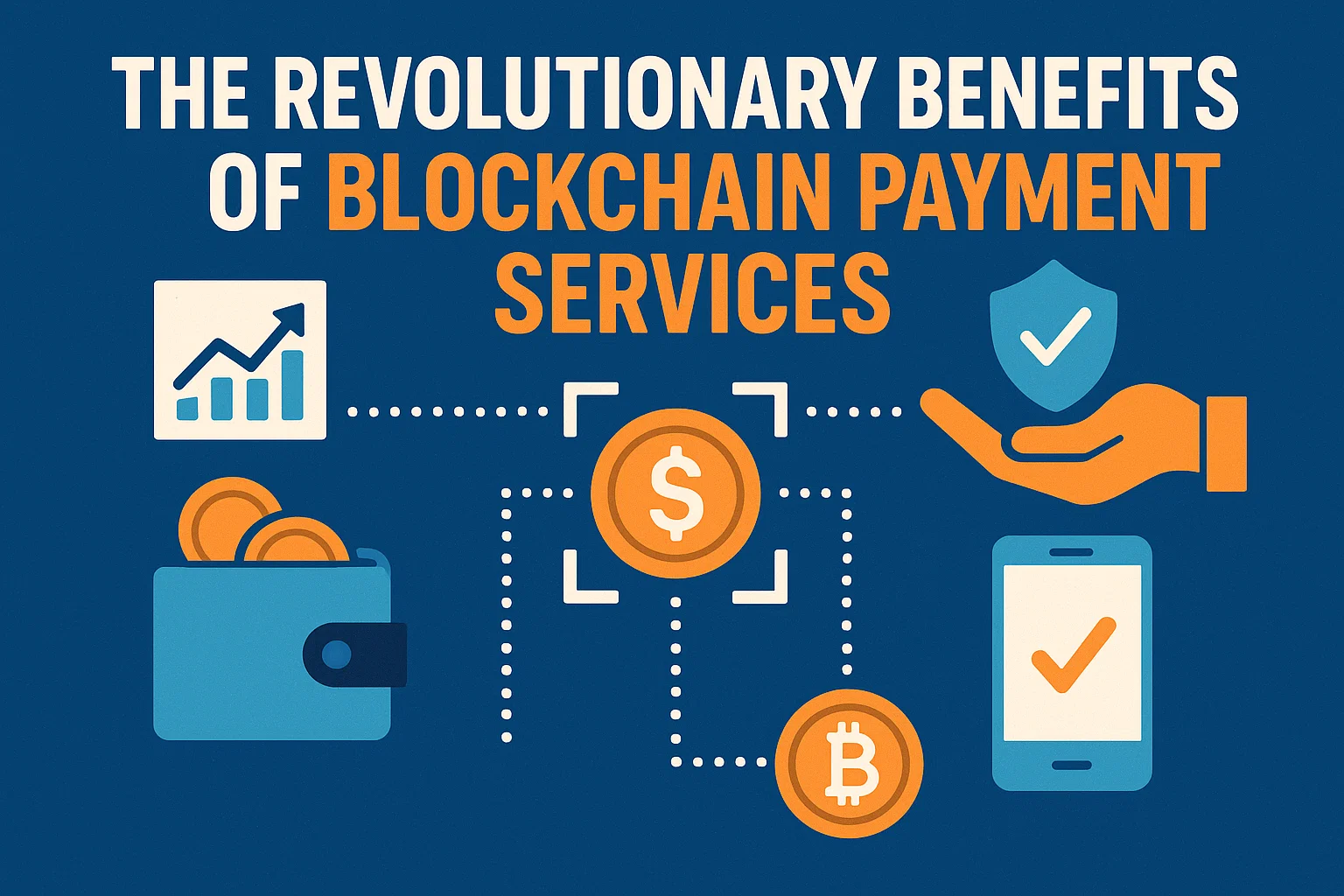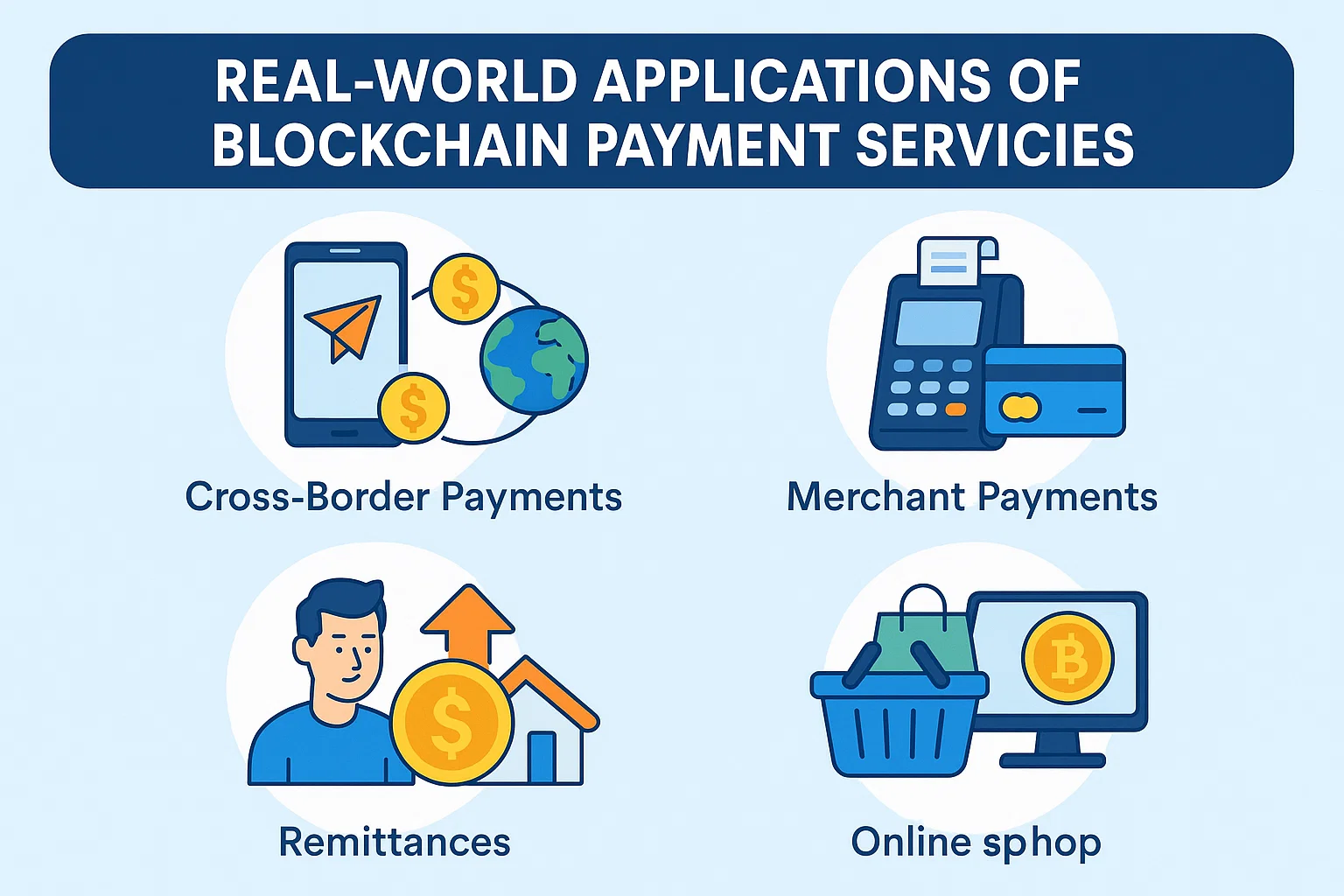The financial landscape is experiencing an unprecedented transformation as blockchain payment services emerge as a game-changing force in global commerce. This revolutionary technology is dismantling traditional barriers that have long plagued conventional payment systems, offering businesses and consumers alike an entirely new paradigm for conducting transactions. With blockchain payment services providing enhanced security, reduced costs, and lightning-fast processing times, the financial industry stands at the precipice of its most significant evolution since the advent of digital banking. The integration of blockchain technology into payment infrastructure is not merely an incremental improvement—it represents a fundamental reimagining of how value flows across borders, industries, and communities in our increasingly interconnected world.
Blockchain Payment Services
What Are Blockchain Payment Services?
Blockchain payment services represent a decentralised approach to financial transactions that leverages distributed ledger technology to facilitate peer-to-peer transfers without intermediary involvement. Unlike traditional payment processors that rely on centralised banking infrastructure, these innovative systems utilise cryptographic protocols and consensus mechanisms to validate and record transactions across a network of computers.
The fundamental architecture of blockchain payment services consists of immutable transaction records stored in interconnected blocks, creating a transparent and tamper-proof ledger. Each transaction undergoes verification through sophisticated algorithms before permanent addition to the blockchain, ensuring authenticity and preventing fraudulent activities that plague conventional payment systems.
Core Components of Blockchain Technology
The technological foundation supporting blockchain payment services encompasses several critical elements. Smart contracts automate transaction execution based on predefined conditions, eliminating manual processing requirements and reducing human error. Cryptographic hashing secures transaction data, making unauthorised alterations virtually impossible. Distributed consensus protocols ensure network participants agree on transaction validity before blockchain inclusion.
These components work synergistically to create a robust ecosystem where digital payment solutions operate with unprecedented efficiency. The decentralised nature eliminates single points of failure, enhancing system resilience against cyber attacks and technical disruptions that frequently compromise centralised payment networks.
The Revolutionary Benefits of Blockchain Payment Services

Enhanced Security and Fraud Prevention
One of the most compelling advantages of blockchain payment services lies in their superior security architecture. Traditional payment systems remain vulnerable to data breaches, identity theft, and fraudulent transactions that cost businesses billions annually. Blockchain technology addresses these vulnerabilities through cryptographic security measures that make unauthorised access extraordinarily difficult.
Each transaction within blockchain payment services receives a unique cryptographic signature that verifies participant identities without exposing sensitive personal information. This pseudonymous approach protects user privacy while maintaining transaction transparency. The immutable nature of blockchain records means once a transaction is confirmed, it cannot be altered or deleted, creating an audit trail that fraud prevention teams can analyse with absolute confidence.
Furthermore, the distributed architecture eliminates the honeypot effect where hackers target centralised databases containing millions of user records. With blockchain payment services, transaction data disperses across thousands of network nodes, making coordinated attacks impractical and significantly raising the barrier for potential security breaches.
Dramatic Cost Reduction
Blockchain payment services substantially decrease transaction costs compared to traditional payment processors. Conventional systems involve multiple intermediaries—banks, payment processors, clearinghouses—each extracting fees that accumulate throughout the payment chain. These costs become particularly burdensome for cross-border transactions where currency conversion and international banking fees can consume 5-10% of transaction value.
By eliminating intermediaries, blockchain payment services reduce these expenses dramatically. Peer-to-peer transactions occur directly between parties, with minimal network fees required only to compensate validators maintaining the blockchain infrastructure. Businesses utilising cryptocurrency payments report cost savings ranging from 40% to 80% compared to traditional payment methods, directly impacting profit margins and enabling more competitive pricing strategies.
Small businesses and entrepreneurs particularly benefit from these reduced costs. Traditional merchant services often require substantial setup fees, monthly charges, and per-transaction percentages that make accepting electronic payments financially challenging for smaller operations. Blockchain payment services democratize payment acceptance by offering affordable alternatives accessible to businesses regardless of size or transaction volume.
Lightning-Fast Transaction Processing
Speed represents another transformative advantage of blockchain payment services. Traditional international payments can require 3-5 business days for settlement as funds navigate through correspondent banking networks and clearinghouse systems. Domestic transactions, while faster, still involve processing delays that create cash flow challenges for businesses awaiting payment confirmation.
Blockchain payment services process transactions in minutes or even seconds, depending on the specific blockchain protocol employed. This acceleration dramatically improves business operations by providing immediate payment confirmation and faster access to funds. E-commerce merchants no longer face lengthy waiting periods before product shipment, reducing inventory holding costs and improving customer satisfaction through faster order fulfilment.
The speed of blockchain transactions proves particularly valuable for businesses operating in fast-paced industries where timing critically impacts competitive advantage. Real-time settlement capabilities enable just-in-time inventory management, immediate vendor payments, and dynamic pricing strategies that would be impossible with traditional payment infrastructure.
Real-World Applications of Blockchain Payment Services

Cross-Border Commerce and Remittances
International trade represents one of the most impactful applications for blockchain payment services. Traditional cross-border payments suffer from high costs, extended processing times, and complex regulatory requirements that burden businesses and consumers. Remittance services, which enable migrant workers to send money to their home countries, extract particularly egregious fees—often 6-8% of the transfer amount—from individuals who can least afford such expenses.
Blockchain payment services transform this landscape by enabling direct international transfers without correspondent banking networks. Businesses can pay overseas suppliers instantly at minimal cost, improving supply chain efficiency and strengthening vendor relationships. Remittance users save hundreds or thousands of dollars annually by utilising cryptocurrency payments that charge flat fees of just a few dollars regardless of transfer amount.
Countries with large remittance-receiving populations particularly benefit from this technology. The Philippines, India, Mexico, and numerous African nations receive billions in remittances annually, with traditional fees representing massive capital outflow. Blockchain payment services return this money to recipients, improving living standards and supporting local economic development.
E-Commerce Integration
Online retailers increasingly adopt blockchain payment services to expand payment options and reduce processing costs. Major e-commerce platforms now support cryptocurrency payments, recognising consumer demand for alternative payment methods and the business benefits of blockchain technology. This integration provides customers with payment flexibility while merchants enjoy reduced chargebacks, lower fees, and faster settlement.
The global nature of blockchain payment services particularly benefits international e-commerce operations. Merchants can accept payments from customers worldwide without establishing banking relationships in each country or navigating complex currency conversion requirements. This accessibility opens new markets for small businesses that previously found international expansion financially prohibitive.
Smart contract functionality within blockchain payment services enables innovative e-commerce applications like automated escrow services that hold payments until delivery confirmation, subscription management that automatically processes recurring charges, and loyalty programs that issue tokens redeemable across merchant networks.
Decentralised Finance (DeFi) Ecosystems
The explosive growth of decentralised finance demonstrates the revolutionary potential of blockchain payment services. DeFi platforms offer financial services—lending, borrowing, trading, and insurance—without traditional financial institutions. These services rely fundamentally on blockchain payment services to facilitate value transfer between participants.
Users can access yield-generating opportunities by lending cryptocurrency through DeFi protocols, earn interest rates substantially exceeding traditional savings accounts, and access loans without credit checks or extensive documentation. All these activities depend on the seamless operation of blockchain payment services that enable instant, secure value transfer across the ecosystem.
The composability of DeFi protocols creates unprecedented opportunities for fintech innovation. Developers combine different services to create new financial products impossible within traditional systems. This experimentation drives rapid evolution in digital payment solutions that increasingly challenge conventional banking supremacy.
Overcoming Challenges in Blockchain Payment Services
Regulatory Compliance and Legal Frameworks
Blockchain payment services navigate complex regulatory landscapes as governments worldwide develop frameworks for cryptocurrency and blockchain technology. Regulatory uncertainty creates challenges for businesses considering blockchain adoption, as compliance requirements vary significantly across jurisdictions and continue evolving as authorities gain technological understanding.
Progressive regulators recognise the innovation potential of blockchain payment services while addressing legitimate concerns about money laundering, tax evasion, and consumer protection. Comprehensive regulatory frameworks balance innovation encouragement with appropriate safeguards, providing businesses with clear compliance pathways that support responsible adoption.
Organisations implementing blockchain payment services must prioritise regulatory compliance through robust know-your-customer (KYC) procedures, anti-money laundering (AML) monitoring, and transaction reporting mechanisms. Proactive engagement with regulators helps shape sensible policies that enable innovation while addressing societal concerns.
Scalability and Network Congestion
Early blockchain payment services faced scalability limitations that restricted transaction throughput during peak usage periods. Network congestion resulted in increased fees and delayed processing, undermining the speed and cost advantages that make blockchain attractive. These technical challenges sparked intensive development efforts to enhance blockchain scalability.
Layer-2 solutions represent one promising approach to scaling blockchain payment services. These technologies process transactions off the main blockchain, periodically settling batches of transactions to the primary network. This approach dramatically increases throughput while maintaining security guarantees, enabling blockchain transactions to compete with traditional payment processors handling thousands of transactions per second.
Alternative consensus mechanisms also improve scalability. While early blockchains relied on energy-intensive proof-of-work validation, newer protocols employ proof-of-stake and other efficient algorithms that process transactions faster with lower environmental impact. These innovations position blockchain payment services as sustainable long-term alternatives to conventional payment infrastructure.
User Experience and Adoption Barriers
Technical complexity represents a significant adoption barrier for blockchain payment services. Managing cryptographic keys, understanding blockchain addresses, and navigating cryptocurrency exchanges intimidate mainstream users accustomed to simple, familiar payment interfaces. Improving user experience remains critical for widespread adoption.
Modern digital payment solutions address these concerns through intuitive interfaces that abstract technical complexity. User-friendly wallets resemble conventional payment apps, hiding blockchain intricacies while providing seamless transaction experiences. Integration with existing e-commerce platforms enables customers to use cryptocurrency payments as easily as traditional methods, reducing friction in the customer journey.
Educational initiatives help potential users understand blockchain payment services benefits and operation. As public awareness grows and younger, tech-savvy demographics enter the marketplace, adoption accelerates. The network effects of growing user bases create virtuous cycles where increased adoption drives ecosystem development, further improving user experiences and attracting additional users.
The Future Landscape of Blockchain Payment Services
Central Bank Digital Currencies (CBDCs)
Central banks worldwide explore issuing digital currencies leveraging blockchain technology, representing official recognition of blockchain payment services. CBDCs would combine cryptocurrency benefits—instant settlement, reduced costs, programmability—with fiat currency stability and government backing. These initiatives could dramatically accelerate blockchain adoption by providing familiar, trusted digital payment options.
Several nations have progressed beyond exploration to active CBDC implementation. These pilots test blockchain payment services at national scales, generating valuable insights about technical requirements, user preferences, and economic impacts. Successful implementations may inspire broader international adoption, potentially transforming global payment infrastructure within the next decade.
The intersection of CBDCs and private cryptocurrency payments will define future payment ecosystems. Rather than competing, these systems may coexist, with CBDCs handling everyday transactions while cryptocurrencies serve specialised use cases like cross-border commerce and decentralised finance applications.
Internet of Things (IoT) Integration
The proliferation of connected devices creates opportunities for innovative blockchain payment service applications. IoT devices equipped with payment capabilities could autonomously conduct transactions—electric vehicles automatically paying charging stations, smart refrigerators purchasing groceries, and industrial sensors compensating data providers. These machine-to-machine payments require the speed, automation, and minimal transaction costs that blockchain transactions provide.
Microtransactions become economically viable with blockchain payment services in ways impossible with traditional payment systems. Content creators can charge fractions of a cent per article view, musicians can receive micropayments for individual song streams, and software can bill by computational resource consumption. This granular monetisation enables new business models that better align payment with value delivery.
Artificial Intelligence and Blockchain Synergy
Artificial intelligence integration enhances blockchain payment services through fraud detection, predictive analytics, and personalised financial services. AI algorithms analyse transaction patterns to identify suspicious activities, protecting users from theft and fraud more effectively than traditional monitoring systems. Predictive models forecast cash flow needs, optimise payment timing, and recommend financial strategies tailored to individual circumstances.
The combination of AI and blockchain creates intelligent digital payment solutions that continuously improve through machine learning. These systems adapt to evolving fraud tactics, changing user behaviours, and emerging market conditions, providing increasingly sophisticated financial services that surpass human capabilities in speed, accuracy, and consistency.
Industry Impact and Economic Transformation
Financial Inclusion and Banking the Unbanked
Blockchain payment services address global financial inclusion challenges by providing banking alternatives to populations underserved by traditional institutions. Approximately 1.7 billion adults worldwide lack bank accounts, excluded from formal financial systems by poverty, geographic isolation, or institutional barriers. This exclusion perpetuates poverty by preventing savings accumulation, credit access, and participation in digital commerce.
Smartphone penetration in developing regions enables blockchain payment services to reach previously unbanked populations. Individuals need only internet connectivity and a mobile device to access financial services traditionally requiring brick-and-mortar bank branches. This accessibility empowers entrepreneurs, strengthens communities, and accelerates economic development in regions where traditional banking infrastructure remains inadequate.
Microfinance institutions increasingly utilise blockchain payment services to reduce operational costs and extend services to more clients. Lower transaction fees mean more capital reaches borrowers rather than being consumed by administrative expenses. The transparency of blockchain transactions also reduces corruption and improves accountability in financial assistance programs.
Supply Chain Finance Revolution
Blockchain payment services transform supply chain finance by enabling real-time visibility, automated payments, and enhanced trust between trading partners. Traditional supply chains involve complex payment arrangements where suppliers often wait 60-90 days for payment after goods delivery. These extended payment terms create working capital challenges that particularly burden small suppliers lacking credit access.
Smart contracts within blockchain payment services automate payment releases based on delivery confirmation, shipment tracking, or quality inspection results. This automation accelerates cash flow throughout supply chains while reducing administrative costs associated with invoice processing, payment reconciliation, and dispute resolution. Suppliers receive payments faster, improving financial stability and enabling business growth.
The transparency of blockchain transactions reduces fraud and counterfeiting in global supply chains. All participants can verify product provenance, shipping history, and payment status, creating accountability that discourages fraudulent practices. This trust enhancement proves particularly valuable for high-value goods, regulated products, and international trade, where verification challenges have historically enabled extensive fraud.
Technical Innovations Driving Blockchain Payment Services
Layer-2 Scaling Solutions
Lightning Network and similar layer-2 technologies revolutionise blockchain payment services by enabling instant, near-zero-cost microtransactions. These protocols establish payment channels between parties, processing numerous transactions off-chain before final settlement on the main blockchain. This approach combines blockchain security with transaction speeds matching or exceeding traditional payment networks.
The scalability improvements from layer-2 solutions position blockchain payment services as viable alternatives for high-volume applications like retail point-of-sale systems, streaming micropayments, and gaming economies. As these technologies mature and gain adoption, the performance gap between blockchain and traditional payment processors continues to narrow.
Interoperability Protocols
Cross-chain communication protocols enable seamless value transfer between different blockchain networks, enhancing blockchain payment services. Early blockchain ecosystems operated as isolated silos where Bitcoin couldn’t interact with Ethereum, and tokens remained trapped within their native networks. Interoperability solutions bridge these networks, creating unified payment ecosystems where users seamlessly transfer value across platforms.
This interoperability proves essential for mainstream adoption of cryptocurrency payments. Merchants and consumers need flexibility to use preferred cryptocurrencies without worrying about compatibility issues. As interoperability improves, blockchain payment services increasingly resemble traditional payment networks, where transaction details remain invisible to users who simply see successful payments regardless of the underlying technical infrastructure.
Security Best Practices for Blockchain Payment Services
Private Key Management
Secure private key storage represents the most critical aspect of blockchain payment services’ security. Unlike traditional accounts protected by passwords that can be reset, blockchain private keys provide irreversible account access. Loss or theft of private keys means permanent loss of associated funds with no recovery mechanism.
Hardware wallets offer robust security by storing private keys on dedicated devices isolated from internet-connected computers. These devices sign transactions without exposing keys to potentially compromised systems. Institutional users of blockchain payment services implement multi-signature schemes requiring multiple parties to authorise transactions, preventing single points of failure and insider theft.
Transaction Verification and Monitoring
While blockchain transactions provide inherent security through cryptographic validation, users must verify transaction details before confirmation. Address verification remains crucial as blockchain transactions are irreversible—funds sent to incorrect addresses cannot be recovered. Modern wallets incorporate address verification features, checksum validation, and transaction previews that help prevent costly errors.
Continuous monitoring of blockchain payment services activity enables prompt fraud detection and response. Anomaly detection systems flag unusual transaction patterns for review, while real-time alerts notify users of account activity. These protective measures, combined with blockchain’s inherent security, create defence-in-depth strategies that maximise fund safety.
Conclusion
The transformation of global payment infrastructure through blockchain payment services represents one of the most significant technological shifts in modern financial history. This revolutionary technology delivers tangible benefits—enhanced security, reduced costs, faster processing, and expanded access—that address long-standing pain points in traditional payment systems. As technical innovations overcome early limitations and regulatory frameworks mature, blockchain payment services increasingly demonstrate their potential to become the dominant payment infrastructure of the digital age.
Organisations that proactively adopt blockchain payment services position themselves at the forefront of financial innovation, gaining competitive advantages through operational efficiency, expanded market access, and enhanced customer experiences. The question for forward-thinking businesses is no longer whether to embrace this technology, but how quickly they can implement blockchain payment services to capitalise on the opportunities this revolutionary era presents.
Read more: What is Blockchain Technology & How Does It Work?




